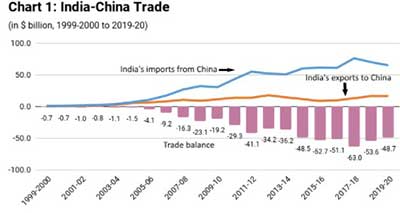Relevance: GS-2: India and its neighbourhood- relations. Effect of policies and politics of developed and developing countries on India’s interests.
GS-3: Indian Economy and issues relating to planning, mobilization, of resources, growth, development and employment. Inclusive growth and issues arising from it. Effects of liberalization on the economy, changes in industrial policy and their effects on industrial growth.
Key phrases: China’s assertiveness, Comparative advantage, Demographic dividend, East Asian growth model, Soft state, Make in India, Global value chains, Indian model, Bureaucracy, skills.
Context:
- Given China’s recent assertiveness India must exercise strategic patience and play a long game, ensure a higher growth than China over the next two to three decades, enabling it to engage with China on a more level playing field.
Background:
- The Chinese economy is more than five times the size of the Indian economy.
- China’s defense capability far outstrips that of India.
- China is also vying for global leadership at the cutting edge of information technology, artificial intelligence and robotics, while India is not even a major player.
- These vast differences in size and capacity leave India at a great disadvantage in engaging with China.
India’s comparative advantages vis-à-vis China:
- The rising demographic share of its young working-age population, while China is facing a serious problem of ageing.
- While India’s rising share of working-age population provides it with a potential high-growth window for the next two to three decades, the so called ‘demographic dividend’.
- China’s annual growth rate had come down to around 6%, about the same as that of India, prior to the pandemic. The key question is whether India can indeed get onto a higher long-term growth path than that of China.
Problems:
- Employer surveys indicate that only about 40% of the Indian workforce have the necessary skills to be productively employable.
- So far, the government’s skilling programmes have had little success.
- This was inevitable, since a major share of the workforce lacks the foundation of basic education necessary to acquire the required skills.
- Eight years of free basic education is now a legal entitlement. But the learning outcomes remain abysmal, reflecting a failure of education policies.
Should India follow East Asian growth models ?
Features of such models:
- East Asian model is an inclusive development strategy based
on high rates of growth of investment, exports and gross domestic
product (GDP) and led by a strong developmental state.
- The institutional framework for it is state-guided capitalism, called “socialism with Chinese characteristics” in China.
- Focus on basic education, skills training and public healthcare,
combined in the initial stages with land reform.
- Apart from making development inclusive, it has ensured the availability of a large educated, skilled and healthy workforce, which is essential for high growth.
- Active nurturing of private enterprise to help firms grow and become globally competitive in selected sectors, i.e. industrial policy a la East Asia.
- A competent and disciplined bureaucracy. Its commitment is ensured by linking career progression to performance.
Challenges with Indian model of growth:
- The Indian state is what Gunnar Myrdal described In Asian Drama
as a “soft” state.
- A highly fractionalized polity with competing interests of different regions, classes, religions and castes, has led to collective action gridlock.
- A large share of the state’s revenues is appropriated for various transfers and unwarranted subsidies to accommodate the many competing special interests.
- Actual growth has not been inclusive at all.
- As Thomas Piketty has recently reiterated (Capital and Ideology), India remains one of the most unequal countries in the world.
- An Oxfam report had showed Indian billionaires increased their wealth by 35% during the lockdown at a time when a quarter of the country was earning less than ₹3,000 per month.
- Instead of nurturing businesses to grow to scales that allow
global competitiveness, India’s regulatory framework has stunted their
expansion, resulting in a highly distorted structure of a few large
enterprises co-existing with hundreds of thousands of small and tiny
businesses.
- Attempts to reform this framework has had limited success.
- The elitist self-image of India’s bureaucracy is reinforced by lifetime job security at high salaries, relative to per capita GDP, and unrelated to performance.

Way forward:
- India has an unprecedented opportunity to chart a China-like, labour-intensive, export trajectory by integrating “Assemble in India for the world” into Make-in-India policy
- It can raise its export market share to 3.5 % by 2025 and 6% by 2030 and could help to create four crore well-paid jobs by 2025 and 8 crore by 2030.
- India’s reforms since 1991 have been haphazard and of s stop and go nature, it poses challenges for country to take full advantage of its demographic dividend. So, India need heterodox policies and reforms
- Indian government needs to understand that vertical industrial policy would not work without a sound horizontal industrial policy.
- India must have laser-like focus on assembling operations on a mammoth scale in network product, wherein production occurs across Global Value Chains (GVCs) operated by multi-national corporations and focus on exports primarily to markets in rich countries
- Gap between China and India in the world market share is almost fully driven by the effect of specialization. On the other hand, India is catching up with China in diversification across products and markets
- India must keep its focus on economic growth, rather than trying to alleviate inequality, given India’s current stage of development, redistribution of wealth is not feasible without growing the overall pie. Moreover the Economic Survey argues that “inequality of opportunity is much more objectionable than inequality of outcomes”. In fact, a perfect equalisation of outcomes “can reduce individuals’ incentives for work, innovation and wealth creation.”
Mains Question.
Q. Analyse the challenges of Indian growth model vis-à-vis East Asian model. Discuss how effectively East Asian model can be replicated with Indian system for overall development.







